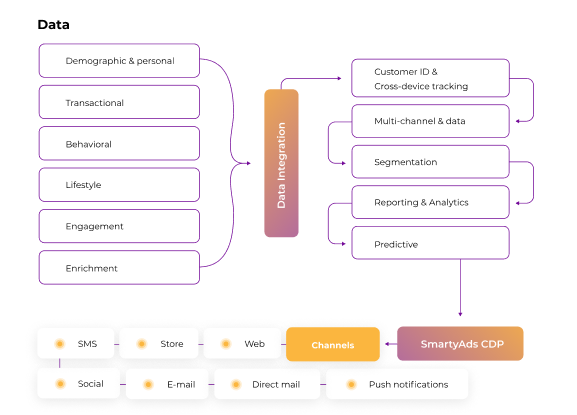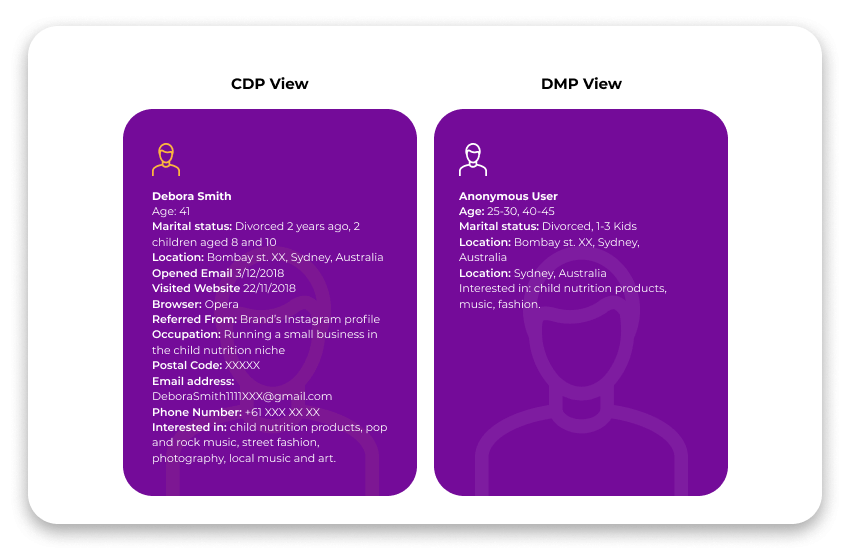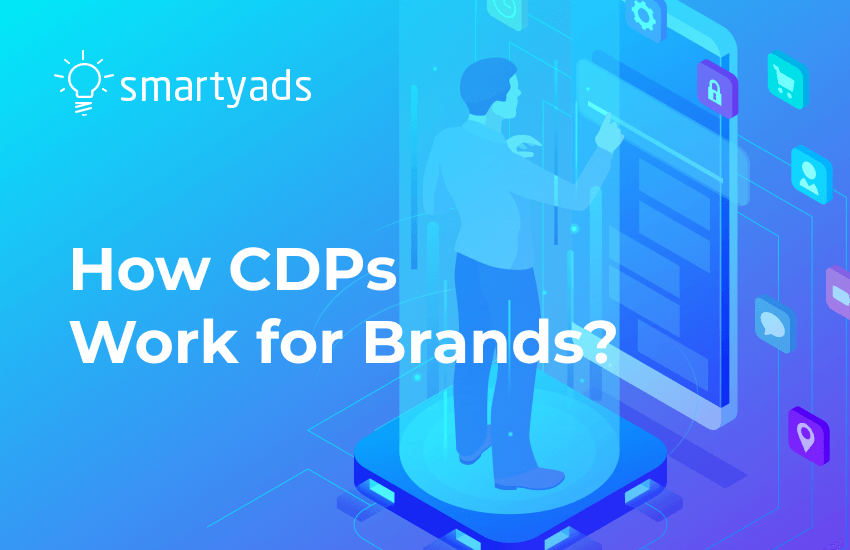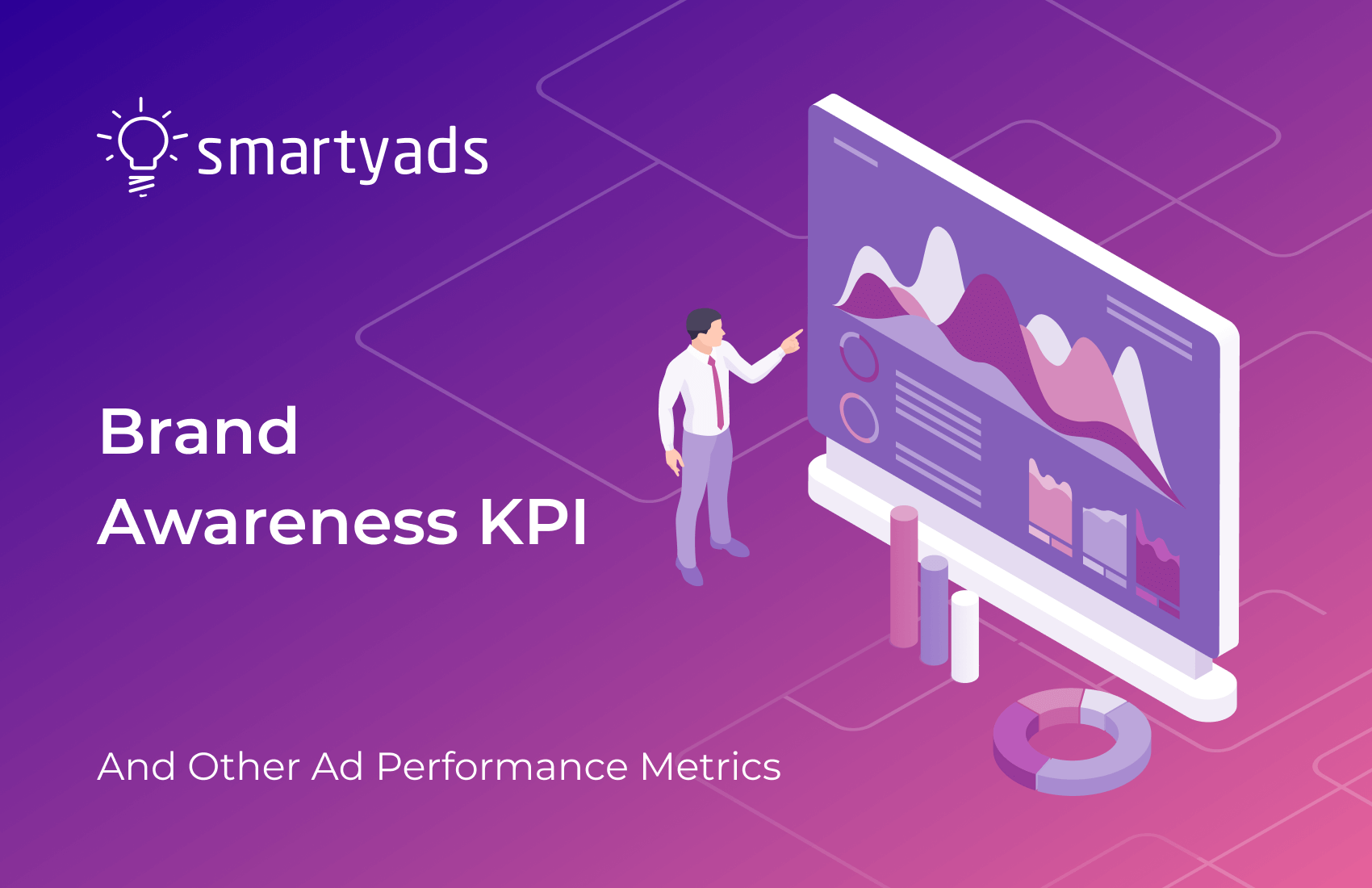What exactly is a CDP (Customer Data Platform)? Is it just another buzzword in the ever-evolving realm of marketing automation, or is it an essential tool every advertiser should have? In today’s fast-paced digital landscape, effectively managing customer data is crucial for crafting personalized experiences. Let’s explore what a Customer Data Platform (CDP) entails and examine the advantages it offers to marketers and advertisers alike.

What is a Customer Data Platform (CDP)?
Customer data platform (CDP) is a marketer-managed tool that collects personally identifiable information (PII) from online and offline sources, creating a unified customer database with single-view customer profiles.

The main purpose of a CDP is not solely customer data storage. CDPs are more about smart data usage aimed at precise customer identification, individual ad message delivery, and creating a stronger bond between brand and customer.
How Does a CDP Work?
A Customer Data Platform (CDP) serves as a critical hub for consolidating customer data from diverse sources, enabling businesses to develop comprehensive and precise user profiles. This integration enhances marketing initiatives and strengthens engagement strategies.
CDPs aggregate information from a broad spectrum of channels, including websites, mobile applications, point-of-sale systems, Internet of Things (IoT) devices, customer service interactions, and marketing platforms. They employ various technologies, such as built-in connectors, software development kits (SDKs), webhooks, and application programming interfaces (APIs), to ensure seamless integration of different types of data — ranging from customer behaviors and transactions to marketing campaign outcomes — into a unified, coherent system. This holistic approach empowers businesses to extract valuable insights and deliver more personalized experiences to their customers.
The core process behind a CDP’s functionality, particularly in the context of customer data platform integrations, is known as identity resolution or data unification. This process involves advanced algorithms designed to “stitch” together data points from different sources. Through identity resolution, a CDP not only validates and deduplicates incoming data but also enriches each profile with additional attributes from first, second, and third-party sources. This continuous integration and validation process ensures that customer profiles remain accurate and up-to-date.
When customer profiles are integrated, a Customer Data Platform (CDP) provides essential tools for analyzing and segmenting audiences. Marketers can efficiently categorize customers according to specific criteria or employ machine learning and artificial intelligence to derive predictive insights. Furthermore, CDPs facilitate customer journey orchestration, allowing marketers to monitor interactions throughout the customer lifecycle. This capability enables the delivery of personalized communications at optimal times and through the most effective channels, ultimately resulting in enhanced engagement and increased customer loyalty.
The Reasons Why Marketers Need Customer Data Platforms
Customer Data Platforms (CDPs) and AdTech have really taken off lately, and it’s easy to see why. They play a crucial role in making marketing more personal and effective. Here are some key reasons why marketers should think about using a CDP ad tech solution:
Access to 1st-Party Data for Ad Targeting
As third-party cookies become less effective due to increasing privacy restrictions and user preferences, first-party data has become crucial for accurate ad targeting. This type of data is collected directly from users who willingly give their consent, aligning with today’s privacy-focused environment. Customer Data Platforms (CDPs) play a vital role in this approach by gathering and organizing first-party data, linking customers' behaviors and preferences with their contact information in a secure, compliant way. This allows brands to deliver targeted ads while fully respecting privacy regulations, fostering greater trust and personalization.
Boosted Conversion Rates
Many brands have reported significant improvements in conversions after using a CDP. For example, Dr. Martens saw a 60% rise in conversion rates, demonstrating how effective CDP platforms can be in driving business results by tailoring interactions and optimizing customer engagement.
Increased Agility in Marketing Decisions
CDPs enable marketers to adapt quickly to market changes by making it easy to add, edit, or remove third-party vendor tags in a few clicks. US Airways achieved a remarkable 401% annualized ROI after implementing a CDP, highlighting the platform's role in supporting agile and responsive marketing efforts.
Seamless Integration with Existing Marketing Tools
Unlike traditional data management platforms, Customer Data Platforms (CDPs) really stand out because they mesh seamlessly with other marketing tools and CRM systems. For instance, if you're using MailChimp, you can take advantage of the data from your CDP to build targeted audience segments.
Improved 1st-Party Data Utilization and Insights
Customer Data Platforms (CDPs) are powerful tools that allow businesses to fully leverage their first-party data. With these platforms, marketers can uncover meaningful insights and fine-tune their audience targeting strategies. Take SmartyAds, for instance — they’re rolling out a CDP designed to give their clients enhanced data insights and sharper targeting. This move is all about boosting the impact of programmatic advertising efforts and helping marketers achieve better results.

Different types of CDP
Customer Data Platforms (CDPs) vary widely, each designed to meet specific business needs by focusing on different functions in data management, analytics, and customer engagement. Here’s an overview of the primary CDP types and how they serve marketers:
Data Collection CDPs
These platforms are all about gathering data from various sources and consolidating it into one system. This helps businesses create a complete picture of each customer. However, they might not have strong features for cleaning up data or automating marketing tasks.
Data Cleansing CDPs
If maintaining top-notch data quality is your priority, Data Cleansing CDPs are the way to go. They focus on tasks like eliminating duplicates, validating information, and standardizing data formats. While they ensure you have accurate data, they might fall short when it comes to launching and automating marketing campaigns.
Analytical CDPs
Analytical CDPs shine when it comes to generating deep insights through sophisticated data analysis and visualization tools. They help brands anticipate trends and understand customer behavior, but they may not be the best for immediate segmentation or managing campaigns effectively.
Campaign CDPs
These are tailored for orchestrating marketing campaigns. CDP in marketing campaigns lets marketers manage and automate multi-channel campaigns from a single platform. While they simplify campaign management, there’s a risk of overlapping campaigns if not monitored closely.
Segmentation CDPs
Segmentation CDPs excel at grouping customers into specific segments based on different criteria, making it easier to target your outreach. They are fantastic for personalized marketing, but if segmentation gets too detailed, it could lead to messaging inconsistencies.
Content CDPs
These platforms connect the dots between customer insights and content delivery, allowing brands to customize messaging based on individual customer preferences. They are outstanding for personalized content marketing but require a lot of detailed metadata to function effectively; plus, they can raise some data privacy concerns.
Retail CDPs
Designed specifically for the retail industry, these CDPs merge data from both online and in-store interactions to paint a full picture of customer behavior. By combining offline and digital shopping experiences, they enhance customer engagement. However, they often depend on complex point-of-sale systems to integrate all that data, making things a bit tricky.
B2B CDPs
These are built with B2B businesses in mind, consolidating information from sources like CRM systems and social media. They support intricate sales cycles and account-based marketing, proving particularly useful for longer sales processes. That said, they might struggle with the complexity of B2B structures and contact hierarchies.
Customer Service CDPs
Customer Service CDPs are all about centralizing interaction data to help support teams offer personalized service responses. They’re fantastic for boosting customer satisfaction, but they may not capture every type of interaction, especially those happening on social media platforms.
Real-Time CDPs
These CDPs are designed for instant data processing, allowing brands to make timely marketing decisions based on up-to-the-minute information. They excel at real-time personalization but often need seamless integration with other systems to keep data accurate in real time.
Choosing the right CDP depends on understanding the unique focus of each type. By selecting a CDP that aligns with their goals — whether for data accuracy, campaign management, or real-time engagement — businesses can more effectively harness customer data for improved outcomes.
Benefits of CDP for Programmatic Advertising
Enhanced Customer Data Management
CDPs provide a streamlined approach to organizing and managing customer data, centralizing first-party data from various sources. This makes it easier to comply with regulations like GDPR and CCPA, as CDPs store only data collected with user consent, respecting customers’ privacy choices.
Improved Data Quality and Real-Time Updates
With CDP advertising, customer profiles are continually updated in real time. If a customer’s behavior or data changes, the CDP can automatically reassign them to a new segment, allowing programmatic advertising platforms to make more accurate, timely adjustments for each bid.
Superior Targeting Precision
CDPs provide a rich set of targeting criteria, including behavioral, geographic, demographic, and contextual data. This level of granularity enhances targeting capabilities, allowing demand-side platforms to reach users with more relevant, personalized ads, improving ad performance and audience engagement.
Increased Flexibility in Data Usage
CDPs are designed to work with both first- and third-party data, giving brands flexibility in how they approach audience targeting. By focusing on first-party data, CDPs enable advertisers to navigate regulatory requirements while leveraging highly accurate customer insights.
Higher Conversion Rates and ROI
The real-time adaptability of CDPs makes them highly effective in programmatic advertising, as updated customer profiles increase the accuracy of bidding strategies. This boosts the likelihood of reaching the right audience at the right time, ultimately leading to higher conversion rates and a better return on ad spend.
Compliance-Friendly Data Tracking
With data privacy laws on the rise, CDPs make it easier to comply with regulations by collecting and storing only consented data. This approach not only builds trust with consumers but also reduces the risks associated with handling sensitive information in programmatic advertising campaigns.
CDP vs. DMP
One difference between those two platforms has already been disclosed: Data management platforms can’t update customers' data. The reason for this is that a DMP collects anonymous, non-PII customer data — tags, cookies, APIs, etc., which has a lifetime of 90 days max. This is mostly 3rd-party data, and that’s exactly why DMPs became less effective in the age of GDPR reign.
DMPs have been successfully used for programmatic advertising personalization based on basic targeting criteria. The new level of targeting precision arrived with the introduction of CDP. The marketers who work with different promotion channels like email, social media, and PPC can also target audiences based on the 1st party data — the unique information about visitors collected while the user interacts with a website.
This type of marketing data may include names, addresses, phone numbers, and details about transactions. Furthermore, CDP usage allows for the generation of a robust, unified profile for every user that provides a marketer with a complete picture.
The last crucial point of different types of data from DMP and a CDP is that the first one stores data in two places: a comprehensive database for all info and its subset for quick use. However, such a storage split makes it harder to integrate other marketing tools. CDPs keep data in one place, so it’s easy to analyze and transmit this data.
Discover more differences between CDPs and DMPs in this article.
The Major Challenge of Customer Data Platforms
The biggest challenge with Customer Data Platforms (CDPs) today lies in their vague and overly broad definition. Without a clear customer data platform industry standard, many tools that don’t fully meet CDP requirements are marketed as CDPs, which can create confusion for buyers.
Misleading Rebranding of Non-CDP Tools
Some companies have rebranded basic tools like tag management or data analytics customer data platform solutions. These tools may not offer the full data unification, segmentation, or activation capabilities that a true CDP should provide, which can lead to disappointment when clients find these solutions lack the depth and functionality they expected.
Overbuilt Solutions for Smaller Brands
On the other end of the spectrum, some CDPs are full-scale, comprehensive solutions designed for large companies managing vast amounts of customer data and complex ad campaigns. For smaller brands that don’t need advanced data processing and targeting capabilities, such CDPs can be too costly and complex, providing far more features than necessary.
Our Approach: A Purpose-Built Solution for Programmatic Advertising
CDP solutions help marketers consolidate data from multiple sources into a single database containing information about all customer touchpoints and interactions. This unified data can then be segmented in nearly limitless ways, enabling more personalized and impactful marketing campaigns. If you're looking for tailored ad-targeting solutions, we’d love to hear from you!
Let’s work together to fine-tune your audience segments and supercharge your ad campaigns. Contact us!





